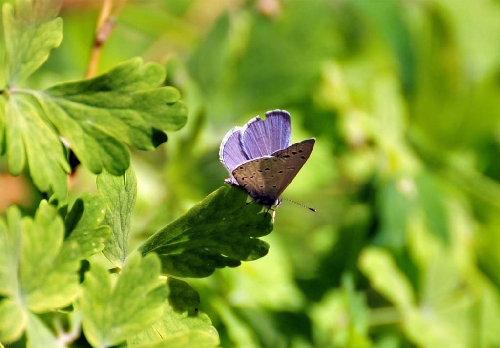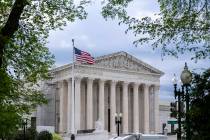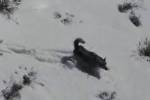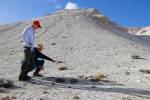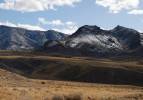Federal wildlife agency recommends protecting Mount Charleston blue, five other butterflies
A dusky blue butterfly so rare even experts can't always find it in the mountains west of Las Vegas is on track to become Nevada's newest endangered species.
The U.S. Fish and Wildlife Service announced Wednesday that the Mount Charleston blue butterfly is in danger of extinction and warrants protection under the Endangered Species Act.
In a Federal Register notice set for publication today , the service also proposes listing as threatened five other butterflies that are similar in appearance to the Mount Charleston blue and occur in the same habitat.
They are the Lupine blue butterfly, Reakirt's blue butterfly, Spring Mountains icarioides blue butterfly and two Spring Mountains dark blue butterflies.
Only trained experts can tell the five varieties apart.
The service determined that a seventh butterfly, the Spring Mountains acastus checkerspot, does not warrant protection at this time.
Wednesday's decision on the Mount Charleston blue was hailed by environmentalists and others fighting to save the insects.
Rob Mrowka is a Nevada ecologist with the Arizona-based conservation group Center for Biological Diversity. He said he is pleased that the service is proposing the highest level of protection there is, higher even than for the desert tortoise, Southern Nevada's best-known federally protected species.
The question is, can the nickel-sized butterfly still be saved?
According to the Fish and Wildlife Service, the Mount Charleston blue is presumed to survive in eight of its 16 historical locations, but its presence has only been confirmed at two of those sites.
Mrowka said recent counts have turned up only a few adults in small, isolated areas high in the Spring Mountains.
"We're down to a handful or a few handfuls of individuals," he said.
Bruce Boyd has been studying butterflies in the Spring Mountains since the mid-1990s. He called the proposed listing "a step in the right direction," but he worries that it may have come too late.
The Mount Charleston blue used to be a common sight in upper Lee Canyon, Boyd said. "Now it's an extreme rarity."
The only place to reliably find the insect these days is in an area no more than a few dozen acres in size on the South Loop Trail high above Kyle Canyon.
Long-term drought and climate change could be impacting the butterfly, but the most immediate threat to the species is habitat destruction, much of it at the hands of the U.S. Forest Service, Mrowka said.
The agency in charge of managing the Spring Mountains National Recreation Area is in the midst of thinning trees and brush to reduce wildfire danger. The problem, Mrowka said, is that the wood being cleared is then fed into a chipper and scattered on the forest floor, covering over butterfly pupae and the plants they depend on.
Boyd said the Forest Service effectively buried the Mount Charleston blue's future beneath all those wood chips.
"The blue won't come back until all that chipping debris is removed," he said, "and it will still take years and years for the habitat to recover."
Officials from the recreation area and the forest service in Nevada could not be reached for comment.
Mrowka believes listing the butterfly as endangered will wind up helping Mount Charleston and the people who enjoy it. Protections will "not inherently" stifle access or development, he said, because the insect's preferred habitat is healthy forest.
One project in particular, the proposed expansion of Las Vegas Ski & Snowboard Resort in Lee Canyon, could benefit the butterfly by opening up more places for it to live out its brief, summertime life-cycle, Mrowka said.
The resort plans to add five new ski runs by the start of this season and several dozen more over the next five or six years. All of that work will be done in close consultation with federal officials, said Kevin Stickelman, president and general manager of the resort.
Stickelman has studied up on the rare butterfly, and he understands the important role the ski area now plays in its survival. Before people came along and began trying to control forest fires, avalanches and erosion, the butterflies lived in sunbathed meadows cleared by natural forces. Now ski runs with names like Blackjack and Bimbo provide the "artificial openings" the insects need in a heavily managed forest, he said.
Stickelman expects the resort's expansion to face delays and complications because of the butterfly, but he doesn't object to its listing.
"We know we're stewards of this mountain," he said. "The best outcome of this whole thing is for us to expand the ski area and at the same time create more habitat for the butterfly to get its numbers up so it can be removed from the endangered species list."
Mrowka has never seen a Mount Charleston blue butterfly in person, but he believes wholeheartedly that it deserves to be saved.
"In the web of life, everything is interconnected, and if you pull at one string, you never know what kind of effect that might have," he said.
Boyd said butterflies often serve as "indicator species" for the overall health of the environment, but the ones on Mount Charleston also provide living examples of the unparalleled diversity there is to be found less than an hour from the Strip.
"I've described the Spring Range as the Galapagos of the Southwest. That's how special those mountains are," Boyd said.
Saving just one tiny insect species there could help protect a much wider area for wildlife and people to enjoy, Mrowka added.
"If we are managing for the butterfly, we will be creating conditions that are favorable to humans," he said. "It's a victory, and I think it's a victory for people who cherish the Spring Mountains."
The Fish and Wildlife Service will open a 60-day comment period to allow the public to review and respond to the proposed listings and provide additional information.
Comments can be submitted on line www.regulations.gov or sent in writing to: Public Comments Processing, Attn: FWS-R8-ES-2012-0069; Division of Policy and Directives Management; U.S. Fish and Wildlife Service; 4401 N. Fairfax Drive, Suite 222; Arlington VA 22203.
The deadline for comments is Nov. 26.
A final decision on listing the butterfly is expected within the next year.
Contact reporter Henry Brean at hbrean@reviewjournal.com or 702-383-0350.
Mount Charleston blue butterfly information




